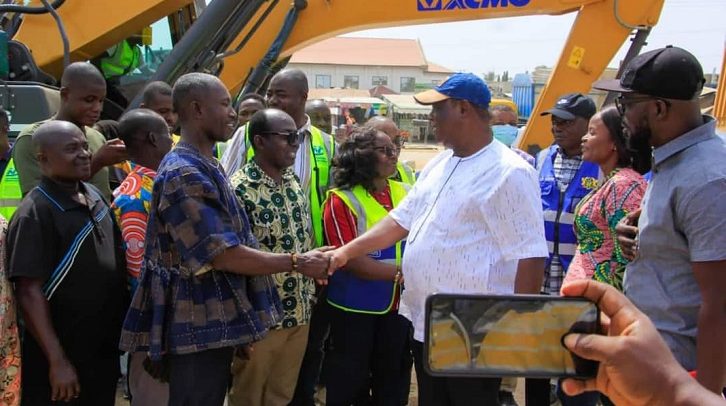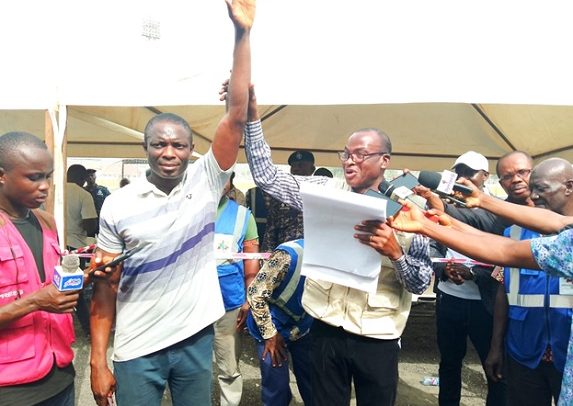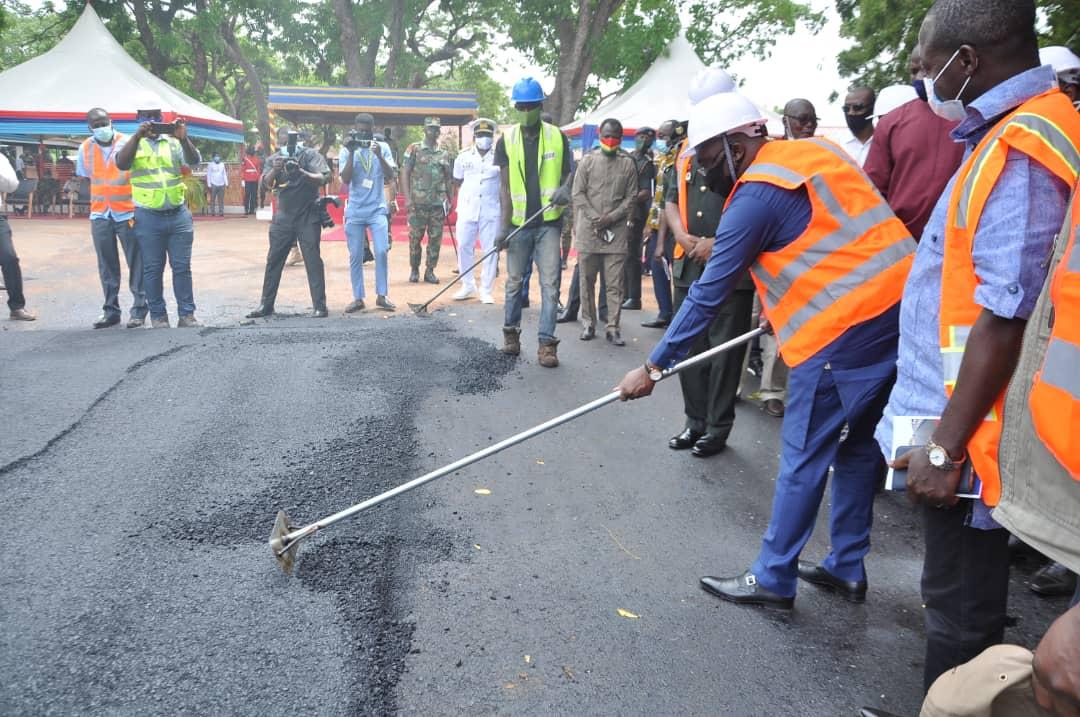
AKOTI, WINNEBA- Six-year-old Ishmeal Arthur wheezes quietly, his small chest rising and falling with effort as he sits beside his mother’s tent along the Kasoa–Winneba highway.
Diagnosed with asthma, Ishmeal’s tiny lungs are constantly under attack, yet his mother, Patricia Arthur, has little choice but to bring him along to her stall near the roadside after school.
His mother, Patricia Arthur, a trader at Akotion theKasoa–Winneba highway, has endured three years of what she calls “a living nightmare.” What should have been a promising road development project has instead turned into a daily ordeal for her and many others living along the corridor. The ongoing road construction, she explains, has disrupted her business and worsened her son’s condition.
“My child goes to school but after school, he comes here. He is really suffering from headaches as a result of the exposure to the dusty road. With him already battling asthma now things are worse. Just this month we have gone to the hospital five times because he keeps getting an attack because I bring him here. All the sales I make at the end of the day go to hospital debts,” Patricia said, wiping dust off her son’s face as she spoke.
As the Kasoa–Winneba road project stretches on, clouds of dust rise daily, coating the air, food, and water of communities along the route. Residents like Patricia are caught between earning a living and safeguarding their health.
Patricia admits she tries to protect herself, but even that is difficult. “I’m not able to wear nose mask because I can’t breathe well in it. We always get home with a headache, and we are pleading with the government to speed up the work here.”
Patricia says she cannot leave her child at home because there’s no one to care for him after school. Despite her efforts to protect Ishmeal with a face mask, the dust always finds a way in. She now wears glasses to ease constant eye irritation, but has yet to visit a hospital herself.
“We are not saying they shouldn’t build the road,” she said softly, “We just want them to finish quickly or at least do it in a way that won’t make us sick.”

The 30 kilometer Kasoa to Winneba project, which began in March 2024 is funded entirely by the Government of Ghana at an estimated cost approaching 180 million dollars, includes construction of interchanges and flyovers at strategic locations including Budumburam, Akoti, Sapato, and Winneba Junction.
It was designed to improve connectivity and spur economic activity across the Central Region. But while bulldozers and graders work to lay asphalt, the very air residents breathe has become toxic. Clouds of dust hover persistently over communities like Liberia Camp, Akoti, Budumburam, Awutu, and Winneba Junction, choking the life out of markets, homes, and schools.
According to the World Health Organization (WHO), air pollution especially from fine particulate matter (PM2.5) is responsible for thousands of premature deaths in Ghana each year. In 2016 alone, over 28,000 Ghanaians died from air pollution–related diseases, including stroke, heart disease, and lung cancer.
For motorbike riders, especially commercial motorbike riders popularly known as “Okada,” the dust is inescapable. KwadjoAppiah, who has been working on the Kasoa–Winneba stretch for the past decade, says the situation worsens daily.
“Sometimes it looks like it’s about to rain, but it’s just dust,” he told this journalist. “Even if you wear a helmet or roll up your car windows, it doesn’t matter the dust still finds you. We cough all the time and get colds. Some people even complain of heart problems.”
He explains the road construction has also created severe traffic congestion, particularly on weekends when commuters return from Accra. “An ambulance carrying a patient from Winneba to Korle Bu can be stuck for an hour. Imagine if that person is in critical condition,” he said, frustration in his voice.
Appiah acknowledges the importance of the road project, but believes it could have been better managed. “The contractor should have left a side route for vehicles. Now, both directions use one lane, and when a car breaks down, everything stops. The dust and traffic are unbearable.”
Dr Emmanuel Duah, a medical practitioner at the Kasoa Polyclinic, has confirmed a steady rise in respiratory cases in communities along the Kasoa–Winneba Road since construction began nearly three years ago.
“In the last three years or so, we have seen fluctuating, but generally high numbers of patients reporting with respiratory infections. While we cannot attribute every case directly to the road works, we know for sure that the dust and congestion are major contributing factors,” he said.
DrDuah explained that continuous exposure to dust, exhaust fumes, and noise from heavy machinery increases the risk of asthma attacks, bronchitis, and other respiratory infections. He added that carbon monoxide from idling vehicles trapped in traffic poses another serious health hazard.
“When vehicles move slowly in long queues, the carbon monoxide they emit fills the air. People inhale it repeatedly, and that can be even more harmful than the dust itself,” he noted.
He cautioned that while the road construction is necessary, it should not come at the expense of residents’ health. “The road is being built for the people, not against them. There must be measures to control the dust and noise like regular wetting of the ground to reduce the health risks,” he said.
DrDuah also appealed to parents to take personal responsibility for protecting vulnerable children, especially those with asthma. “If your child is allergic to dust, keeping them along the roadside stalls all day only worsens their condition,” he advised.
He urged both contractors and authorities to speed up the work and enforce safety measures, warning that “everyone using this road is at risk until proper controls are in place.”
EPA Steps Up — But Will It Be Enough?
Ghana’s Environmental Protection Agency (EPA) has long flagged road dust as a major contributor to deteriorating air quality. Enforcement of measures like regular road watering and dust barriers has often been inconsistent.
But in a significant development, on September 6, 2025, the EPA’s Chief Executive Officer, Professor Nana Ama Brown Klutse, announced that Parliament had passed the Air Quality Management Regulation into law. She described it as a long-awaited milestone that would empower the EPA to better enforce air quality standards and demand accountability.

Prof. Klutse said the new regulation will require the establishment of an Air Quality Information Management System, and that EPA will depend on data contributions from stakeholders across industry, transport, and local government.
She also emphasized that clean air is a fundamental right and that “we are racing against time for clean air, racing for solutions, racing for survival for the entire ecosystem.”
Yet, even with these advances, residents along the Kasoa–Winneba corridor say they see little evidence of enforcement. The persistent haze becomes a daily reminder that policy, data, and actual life experience still struggle to meet in the same storm.

Figure 1– From the image above, the reporter travelled from Kasoa to Winneba and back on public transport while carrying an air-pollution monitor, and the device showed that the air along the road contained dangerous levels of particulate matter.
At some points, the pollution spiked as high as 1,600 micrograms per cubic meter, what experts called “disturbing” levels of air pollution. Between 11:00 am and 2:00 pm, the readings varied widely: the lowest level recorded was 6.88, the average was 58.53, and most of the readings fell between about 15 and 58, although the highest spike during this period reached 1,648.60.
The data also showed that each side of the road had different levels of pollution, meaning where a person sits or stands on the route affects how much polluted air they breathe.
 Figure 2– This gradient visualization helps identify which sections of the journey between Kasoa and Winneba had higher or lower concentrations of air pollution. The darker blue/purple colors along the route indicate areas where the air quality monitor detected the lower levels of dangerous particulate matter (around 200-400 ?g/m³), while lighter yellows would indicate relatively higher concentrations.
Figure 2– This gradient visualization helps identify which sections of the journey between Kasoa and Winneba had higher or lower concentrations of air pollution. The darker blue/purple colors along the route indicate areas where the air quality monitor detected the lower levels of dangerous particulate matter (around 200-400 ?g/m³), while lighter yellows would indicate relatively higher concentrations.
For context, these are extremely high pollution levels the WHO recommends PM2.5 levels should not exceed 15 ?g/m³ for 24-hour exposure, so even the “better” sections of this route show pollution levels far exceeding safe standards.
Dr. Collins Gameli Hodoli, Founder of Clean Air One Atmosphere (CAOA), on his part explained that the major pollutants from road construction are particulate matter specifically PM10 and PM2.5 tiny particles that easily enter the lungs and bloodstream, leading to respiratory and cardiovascular diseases.
“Particulate matter, especially PM2.5, is the major component of road dust. But there are also heavy metals like lead, polyaromatic hydrocarbons from combustion, silica, and gases such as nitrogen dioxide and carbon monoxide from diesel engines,” Dr. Hodoli said.
He emphasized that continuous exposure to such pollutants could trigger long-term health conditions including asthma, cancer, and reduced lung development in children.
To reduce these dangers, Dr. Hodoli called for real-time air quality monitoring along major construction sites. He recommended that low-cost sensors be installed every two kilometres along the Kasoa–Winneba stretch to detect rising pollution levels and guide immediate emergency responses such as ground watering or temporary traffic control.
“These sensors are not expensive. They can alert contractors when dust levels become dangerous so action can be taken immediately. If you don’t measure, you can’t manage,” he noted.
Dr. Hodoli further urged the Environmental Protection Agency (EPA) to ensure strict enforcement of the new Air Quality Management Regulation passed by Parliament and to establish “air quality marshals” to monitor compliance on-site.
“Our health is our wealth. We must treat air pollution as an emergency, not as a background issue. The dust people breathe today could shape their health for a lifetime,” he stressed.
A public health expert, Nana KwekuKwakye, also called for stronger regulatory oversight and community engagement in major infrastructure projects, following rising complaints of dust pollution along the ongoing Kasoa–Rinneba Road construction.
Mr. Kwakye said the situation highlights a recurring governance gap in Ghana’s environmental and public health management, where development projects proceed without adequate safeguards for affected residents.
“There isn’t an inherent tension between development and the right to a healthy environment. The problem lies in how policies are implemented and enforced. If environmental permits and impact assessments are weak or ignored, then the public bears the cost of poor planning,” he argued.
Mr. Kwakye attributed the situation to ineffective local governance systems, saying weak district-level structures prevent communities from escalating their grievances for redress. “Our local government structures are supposed to be the first responders in situations like this, but many are not functioning as intended,” he noted.
He urged both government and contractors to act swiftly to mitigate health risks by regularly watering the roads, communicating environmental risks to residents, and completing the project on schedule. “Mitigation and transparency are key communities need real-time information about risks so they can protect themselves,” he emphasized.
The expert further called for stronger collaboration between the EPA, district assemblies, and civil society groups to ensure environmental justice. “Development must not come at the expense of people’s health. We need a just and accountable system that balances growth with human well-being,” he said.
Mr. Kwakye urged both government and contractors to act swiftly to mitigate health risks by regularly watering the roads, communicating risks to residents, and completing the project on schedule. “Mitigation and transparency are key—communities need real-time information about risks so they can protect themselves,” he emphasized.
He also called for stronger collaboration between the EPA, district assemblies, and civil society groups to ensure environmental justice saying development must not come at the expense of people’s health. We need a just and accountable system that balances growth with human well-being,” he said.

The Cost of Progress
For people like Patricia Arthur and her son, the road project is both a symbol of hope and hardship. While it promises development, its execution has come at a painful cost.
Until authorities act on the urgent measures experts have outlined, families along the Kasoa–Winneba stretch will continue to suffer with every breath they take.
The post Breathing Danger: How the $180m Kasoa–Winneba Road Project Is Choking Residents appeared first on The Ghanaian Chronicle.
Read Full Story


















Facebook
Twitter
Pinterest
Instagram
Google+
YouTube
LinkedIn
RSS